by Rachel Pienta | Feb 15, 2019
The 4-H Exchange Experience in the NW District

Sali and Gregor received a brief orientation to 4-H and life in the United States soon after their arrival.
Wakulla 4-H welcomed two international students via the Future Leaders Exchange Program at the beginning of September. The students, who are living with volunteer host families this school year, have become active 4-H members during their stay. Sali Polotov is from Tajikistan and is interested in studying geological science. Gregor Johanson is from Estonia and is interested in the performing arts. Both students attend 11th grade at Wakulla High School.
Eye Opening Experiences
Since their arrival, they have been part of the 4-H District III Council and attended Leadership Adventure Week where Gregor led a workshop on trust and communication.
During a recent interview with the 4-H Academic Year Program (AYP) FLEX students, Sali and Gregor reflected on their experiences at the midpoint of their year. Gregor shared it had always been a dream to study overseas. He saw an Instagram advertisement and decided to apply. He did not know about 4-H and learned about it after being accepted to the Academic Year Program. Since coming to the United States, he said has experienced some surprises. He was surprised by the American “addiction to fast and unhealthy food” and he has observed “that it seems to be more prevalent in rural areas.”
“There have been a lot of things that have surprised me, good things and bad things. Some of the good things include much friendlier and welcoming customer service, as well as a wider range of options for everything everywhere.”
– Gregor Johanson
Sali shared that he was motivated to come to the United States because he wanted to see the reality versus what was depicted in movies he had seen in Tajikistan. While Sali said that he knew nothing about 4-H before coming to Florida, he has enjoyed the opportunities to participate in 4-H clubs, special events and volunteer work.
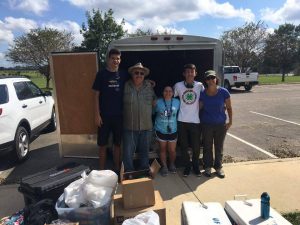
Sali Polotov joined other Wakulla 4-H members to deliver relief supplies to the NFREC office after Hurricane Michael.
One thing that surprised Sali about American life was how “American people love holidays. They do all of their best to spend an unforgettable moment.” Sali shared he has especially enjoyed his experiences volunteering in the aftermath of Hurricane Michael, snorkeling with manatees and celebrating Christmas with his host family.
Both young men are looking forward to an upcoming trip to Disney World and having more adventures with 4-H before their year in the United States concludes.
The Future Leaders Exchange Program (FLEX)
Since 1993, the FLEX Program has provided scholarships for high school students from Europe and Eurasia to spend an academic year in the United States while living with a family and attending an American high school. Florida 4-H partners with the FLEX program through the States’ 4-H International Exchange Programs. Students have opportunities to engage in both short-term summer programs and academic year exchange experiences. Nearly 60,000 youth and families have been positively impacted by international exchange through States’ 4-H programs since 1997.
The FLEX program is a competitive, merit-based scholarship program funded by the U.S. Department of State. Students gain leadership skills, learn about American society and values, and teach Americans about FLEX countries and cultures. The primary goal of the FLEX program is to improve mutual understanding and develop and strengthen long-term relationships between citizens of the United States and other peoples and countries. There are currently 17 countries that participate in the FLEX program: Armenia, Azerbaijan, Estonia, Georgia, Kazakhstan, Kyrgyzstan, Latvia, Lithuania, Moldova, Mongolia, Montenegro, Poland, Romania, Serbia, Tajikistan, Turkmenistan and Ukraine. Not all 4-H AYP students come to Florida through the FLEX program and students may come from other partner countries.
How to Get Involved with the 4-H AYP Program:
Families can become qualified to host an international student for the 10 month Academic Year Program by applying at https://states4hexchange.org. For more information, contact Georgene Bender, Florida 4-H AYP Coordinator, UF/IFAS Extension Faculty Emeritus – gmbender@ufl.edu.
For more information about this program or other 4-H programs in your county, contact your local UF/IFAS Extension Office.
Additional Resources:
by Rachel Pienta | Dec 12, 2018
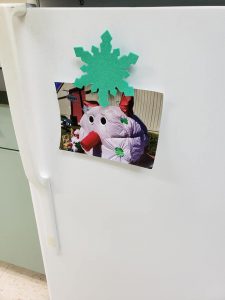
Here’s an example of a decorated clothespin magnet holding a photo.
Slow Down to Savor the Season
The weeks leading up to the gift-giving holiday season can be hectic and stressful. Full social schedules and crowded stores can make Christmas seem like an expensive chore. One way to restore some of the joy of the season and regain some valuable family time is to make thoughtful giftsathome.
Craft a Gift That Everyone Can Use
Every year, the postal service brings glossy family photo cards to my home from friends near and far. Our family likes to make them part of the festive décor for the holiday season by displaying them with homemade r refrigerator magnets. This magnet craft is one you can make with your entire family or at a 4-H Club meeting and give them as gifts.
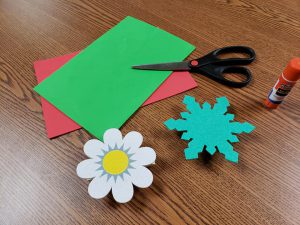
Foam board cut outs can be glued to the clothespin to make fun magnets to give as gifts.
Basic Items to Get Started
Square wooden clothespins
Glue
Scissors
Adhesive magnet strips
Craft foam sheets
Markers
Glitter
Ribbon
We have decorative magnets and like to rotate them with the season. Decorative details are limited only by your imagination and the weight that the magnets will support. Trial and error with magnet strength is recommended and is a great way to spark a STEM discussion while creating art together!
Follow these simple instructions:
- Measure the magnet strip to cover the “back” of the clothespin.
- Cut to length. (Adults may need to help younger kids with this.)
- Attach the magnet strip to the “back” of the clothespin.
- Add decorations or art work like foam cutouts to the “front” of the clothespin.
Gift Ideas
- Packaging the magnetic clothespins with a family photo or a child’s artwork.
- Using a decorated clothespin magnet to hold a gift tag and include with a larger wrapped gift.
- Giving cookies or other baked treats? Clothespin magnets make great recipe holders!
4-H is a great place for your child to express their creativity. For information about 4-H in your county, please click here.
Additional Ideas & Resources for Clothespin Magnets
DIY Clothespin Magnets!
https://www.diynetwork.com/how-to/make-and-decorate/crafts/how-to-make-refrigerator-magnets-from-clothespins
Teachers Gifts: DIY Magnetic Clothespins
by Rachel Pienta | Sep 21, 2018
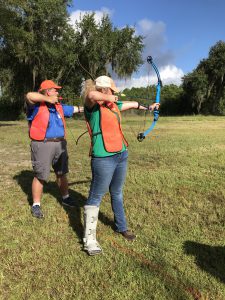
4-H Volunteers learn and practice the archery pre-shot routine so they can teach it to their youth. Photo: Julie P. Dillard
Ready to Lead
Sixteen 4-H volunteers joined ranks with one of Florida 4-H’s largest projects by earning their Level One Shooting Sports Instructor certification September 8. Training participants included 4-H volunteers and UF/IFAS Extension staff from Escambia, Holmes, Jefferson, Marion, Wakulla, Walton, Union and Alachua counties. What sets 4-H instructor training apart from other shooting sports trainings is the focus on youth life skills and positive youth development as opposed to focusing only on skill mastery.
About Florida 4-H Shooting Sports
The 4-H Shooting Sports Program teaches young people safe and responsible use of firearms, principles of archery and hunting basics. Lifelong skill development is one of the main benefits of involvement in the 4-H Shooting Sports Program and applies to both youth and adults involved in the program. Specifically, the 4-H Shooting Sports Program is designed to:
- Provide youth proper training in the use of firearms, archery equipment, and other areas of shooting sports.
- Provide thorough instruction in shooting sports safety.
- Develop life skills such as self-confidence, personal discipline, responsibility, and sportsmanship
- Create an appreciation and understanding of natural resources and their wise use.
- Provide volunteer instructors safe and proper instructional techniques.
- Show volunteer leaders how to plan and manage 4-H Shooting Sports Clubs. (Culen et al, 2018).
Resources for Success
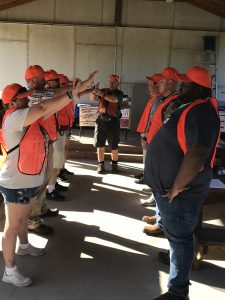
Establishing eye dominance is one of the first tasks of new member. Photo: Julie P. Dillard
It’s important to equip agents, volunteers and youth with the tools they need to succeed in the Florida 4-H Shooting . To assist you in organizing the county shooting sports program, here are some resources from the 4-H State Shooting Sports Committee and Environmental Sciences Action Team:
State Match Information, Rules and Risk Management
Youth Project Books
Getting Organized
To learn more about your county shooting sports program, contact your local 4-H agent.
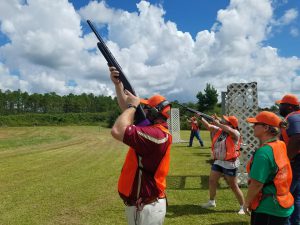
Wakulla 4-H Shooting Sports Club Leader, David Pienta, takes aim during shotgun instruction. Volunteers practice peer teaching to get ready to teach 4-H youth.
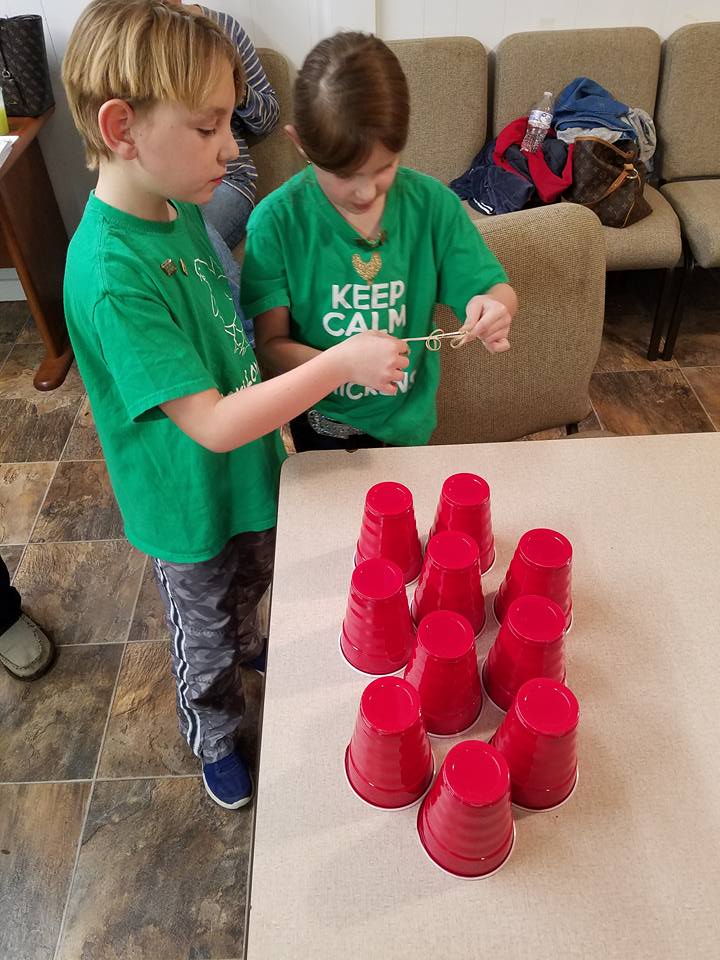
by Rachel Pienta | Jun 15, 2018
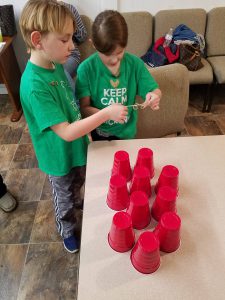
4-H members play the stacking game at a club meeting.
Summer is here, and I’m picturing long and lazy sunny days at the lake or beach. In Florida, the warm, sunny days of summer also bring afternoon thunderstorms and the possibility of tropical storms and occasional hurricanes.
What to do on rainy summer days?
During the summer months, the days of sunshine may be interrupted with periods of rainy weather. For children, rainy weather often means long hours spent inside the house. While some children welcome rainy days to spend time curled up with a book, reading for hours at a time will not occupy every child.
For parents looking for indoor activity options for children beyond movie marathons and video games, using household items already on hand can provide fun alternatives to endless screen time.
STEM CHALLENGE AT HOME
A fun activity that only requires string, rubber bands, and sturdy plastic cups will challenge your children to work together and think creatively to problem solve. The “Stack ‘Em Up: Introduction to Engineering Activity” challenges children to think like engineers. The activity is best done with 4 to 6 children. This is a great activity for children to enjoy when the neighborhood group converges on your house for a rainy afternoon! A complete instruction guide for this activity is included in the links below this article.
HOME KITCHEN CHALLENGE
A number of popular television cooking shows involve challenge competitions with special or limited ingredients. Parents can adapt this concept to help their children develop basic cooking skills while also giving them an opportunity to be creative and problem solve. This “do it yourself” at home cooking competition, adapted from PBS Kids, offers an easy fun way to engage children in creative kitchen fun:
• Divide the kids (or kids and adults) into 2 or 3 teams of 1 – 2 people.
• Gather a set of cooking items for each team – utensils, measuring instruments, bowls, etc.
• Choose an adult or older child to be the judge and/or the announcer/assistant. The judge can also decide on the “Secret Ingredient” that will be revealed to the contestants. Consider making it a fruit, a raw vegetable like carrot, cucumber, or celery, a grain item such as bread or cracker, or a spice like ginger or cinnamon.
• Set up individual or team “cooking stations”. Your cooking competition may be preparation only – without a stove, microwave, or oven.
Plan in time for taking turns cooking if your items will need to be heated or if appliances such as blenders or stand mixers will be used.
To add an additional layer of challenge, parents can decide to limit each time to one preparation method for individual teams or across all teams.
• Decide ahead of time how many additional ingredients competitors may “shop” for in the kitchen.
• Designate a separate spot for the judge or multiple judges to taste the food. This station should be equipped with a plate and eating utensils, and a palate cleanser like water or crackers. For more fun possibilities, create scoring cards with categories for taste, originality, good humor or sportsmanship, and presentation.
• Use a timing device like a kitchen or cell phone timer to add in the time element to the challenge. The suggested competition time is 20 minutes. The 20-minute time should include the child’s recipe planning time. Decisions will need to be made quickly!
• When time’s up, have each team present their creation to the judge, including a verbal description of flavors and the preparation technique. The judge(s) can taste each one and fill out the scorecards.
• Need ideas for prizes? Consider awarding a new cooking utensil like a colorful spatula with a certificate or card declaring the winner(s) “Master(s) of the Grand Spatula!”
• Want to involve additional older children or adults? Designate reporters to videotape and interview the contestants. Extend the fun by watching all the videos once the competition ends or before the winners are announced.
WHEN IT RAINS, GROW CREATIVE FUN FAMILY TIME AT HOME
The next time the summer forecast calls for rain, be prepared with these “rainy day” activity ideas. For more ideas, please contact your local UF/IFAS Extension Office.
How to Create a Cooking Challenge for Kids
How to Host a Cooking Competition for Your Kids
Stack ‘Em Up Activity
http://ngcproject.org/sites/default/files/9.6_stack_em_up_activity.pdf
https://www-tc.pbskids.org/fetch/games/activities/pdf/FETCH_StackEmUp.pdf









